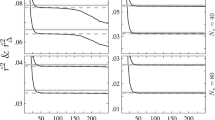Abstract
A diploid population is analyzed with respect to the set of L autosomal loci. The attention is focused on the description of possible gametic disequilibria defined as deviations of the current population state from the reference state with the same allelic concentrations but with independent combination of alleles in gametes. The disequilibrum description is not based on any assumptions about microevolution factor pressures, generation overlapping, mating systems, etc. It is simply used to represent the current genetic structure of the population in terms of gametic disequilibria and allele concentrations. As the indicators of linkage disequilibrium, the basis vectors of subspaces of admissible deviations are chosen that were originally suggested as eigenvectors of a linearization matrix for the model of generalized nonepistatic selection in a series of papers by S. Karlin and U. Liberman. In the present paper, these characteristics are considered from a completely different, new point of view, namely, as the basis gametic disequilibria, and admissible deviations are decomposed into the basis ones. The disequilibrium hierarchical organization with respect to inducing marginal deviations from appropriate reference states on the locus subsets of different sizes is revealed. Each of the basis disequilibria is characterized by a set of loci K, the so-called deviation support. For a basis disequilibrium of a certain level of hierarchy, there is a threshold m (equal to the quantity of loci in K) for the number of loci which is necessary for that disequilibrium detection. Thus, it is required to analyze no less than m loci simultaneously to reveal the existing basis deviation from linkage equilibrium. The justification of the results is based on the use of linear algebra machinery, Kronecker multiplication, and linear subspace of admissible deviations. Properties of marginal deviations on various subsets of loci are considered in terms of gametic disequilibria.
Similar content being viewed by others
References
Zhivotovskii, L.A., Integratsiya poligennykh sistem v populyatsiyakh (Integration of Polygene Systems in Populations), Moscow: Nauka, 1984.
Zhivotovsky, L.A. and Gavrilets, S., Quantitative variability and multilocus polymorphism under stabilizing selection, Theor. Popul. Biol., 1992, vol. 42, pp. 254–283.
Kirkpatric, M., Johnson, T., and Barton, N., General models of multilocus evolution, Genetics, 2002, vol. 161, no. 4, pp. 1727–1750.
Ahmed, M. and Liang, P., Study of modern human evolution via comparative analysis with the Neanderthal genome, Genomic Inf., 2013, vol. 11, no. 4, pp. 230–238.
Tassi, F., Ghirotto, S., Mezzavilla, M., et al., Early modern human dispersal from Africa—genomic evidence for multiple waves of migration, Invest. Genet., 2015, vol. 6, pp. 6–13.
Geneticheskii passport—osnova individual’noi i prediktivnoi meditsiny (The Genetic Passport—the Basis for Individual and Predictive Medicine), Baranov, V.S., Ed., St. Petersburg: N-L, 2009.
Slatkin, M., Linkage disequilibrium—understanding the evolutionary past and mapping the medical future, Nat. Rev. Genet., 2008, vol. 9, no. 6, pp. 477–485. doi 10.1038/nrg2361
Hedrick, P.W., Genetics of Populations, Boston: Jones and Bartlett, 2003.
Markus, M. and Mink, X., A Survey of Matrix Theory and Matrix Inequalities, Prindle: Weber and Schmidt, 1964.
Lancaster, P., Theory of Matrices, New York: Academic, 1969.
Hansen, T.F. and Wagner, G.P., Modeling genetic architecture: a multilinear theory of gene interaction, Theor. Popul. Biol., 2001, vol. 59, no. 1, pp. 61–68.
Karlin, S. and Liberman, U., Global convergence properties in multilocus viability selection models: the additive model and the Hardy–Weinberg law, J. Math. Biol., 1990, vol. 29, no. 2, pp. 161–176.
Pasekov, V.P., About multilocus genetic structure of a population: 2. Dynamics of gametic nonequilibrium as a result of recombination processes and segregation, Russ. J. Genet., 2017 (in press).
Geiringer, H., On the probability theory of linkage in Mendelian heredity, Ann. Math. Stat., 1944, vol. 15, no. 1, pp. 25–57.
Li Ching Chun, First Course in Population Genetics, Pacific Grove: Boxwood, 1976.
Svirezhev, Yu.M. and Pasekov, V.P., Osnovy matematicheskoi genetiki (Fundamentals of Mathematical Genetics), Moscow: Nauka, 1982.
Lewontin, R.C. and Kojima, K., The evolutionary dynamics of complex polymorphisms, Evolution, 1960, vol. 4, no. 4, pp. 458–472.
Bennett, J.H., On the theory of random mating, Ann. Eugenics, 1954, vol. 18, pp. 311–317.
Slatkin, M., On treating the chromosome as the unit of selection, Genetics, 1972, vol. 72, no. 1, pp. 157–168.
Author information
Authors and Affiliations
Corresponding author
Additional information
Original Russian Text © V.P. Passekov, 2017, published in Genetika, 2017, Vol. 53, No. 6, pp. 740–755.
Rights and permissions
About this article
Cite this article
Passekov, V.P. On multilocus population genetic structure: I. Description of gametic disequilibrium architecture. Russ J Genet 53, 719–731 (2017). https://doi.org/10.1134/S1022795417050076
Received:
Accepted:
Published:
Issue Date:
DOI: https://doi.org/10.1134/S1022795417050076



